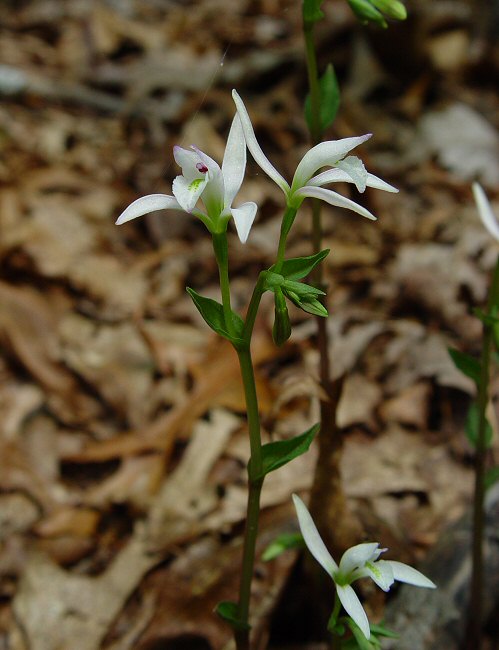Triphora trianthophoros (Sw.) Rydb.
Three Bird Orchid

Native
CC = 9
CW = 0
MOC = 29
© DETenaglia
Triphora trianthophoros (Sw.) Rydb.Three Bird Orchid | |
 |
Native CC = 9 CW = 0 MOC = 29 |
© DETenaglia |
|
Family - Orchidaceae Habit - Perennial forb from tuberous root bases and stolons (the tubers forming at the tips of the stolons). Stems - To +15cm tall, herbaceous, erect, fleshy, purplish at base, glabrous, forming small colonies. Leaves - Alternate, clasping, scalelike below, becoming ovate above, acute, entire, glabrous, to +/-1.2cm long, +/-9mm broad.
Inflorescence - Single axillary flowers, typically 3-4 per plant. Flowers erect (but nodding while in bud). Pedicels erect, to 1cm long, glabrous. Flowers - Whitish, to 2cm long. Floral tube -5mm long, glabrous. Petals 3. Lower petal white, 1.4cm long, greenish, with a bearded strip internally, 3-lobed. Central lobe to +5mm long, with eros margins. Lateral lobes rounded, 2-3mm long. Upper petals linear, white, 1.6cm long, 2-3mm broad. Column 1.1cm long, green at the base, white apically, glabrous. Pollinia purple. Pollen pinkish-purple. Ovary inferior, unilocular. Placentation parietal. Sepals 3, white, glabrous, 1.8cm long, 2-3mm broad, subfalcate, cupped. Petals and sepals sometimes with a purplish tinge.
Fruit - Capsules nodding during development, erect at maturity, 10-15 mm long, elliptic, strongly ribbed. Seeds numerous, dustlike.
Flowering - July - October. Habitat - Mesic woods, ravines, stream valleys, bottomland forests. Origin - Native to the U.S. Lookalikes - None when flowering. Other info. - This small species is mainly found in the lower 1/2 of Missouri. The white flowers only last for one day and are frequented by bees from the family Halictidae. Flowering is triggered by specific weather conditions, and populations of plants in a common area will commonly all flower on the same day. Photographs taken at the Sunklands Conservation Area, Shannon County, MO., 7-28-04 (DETenaglia); also at Babler State Park, St. Louis County, MO, 9-10-2018 (SRTurner). |